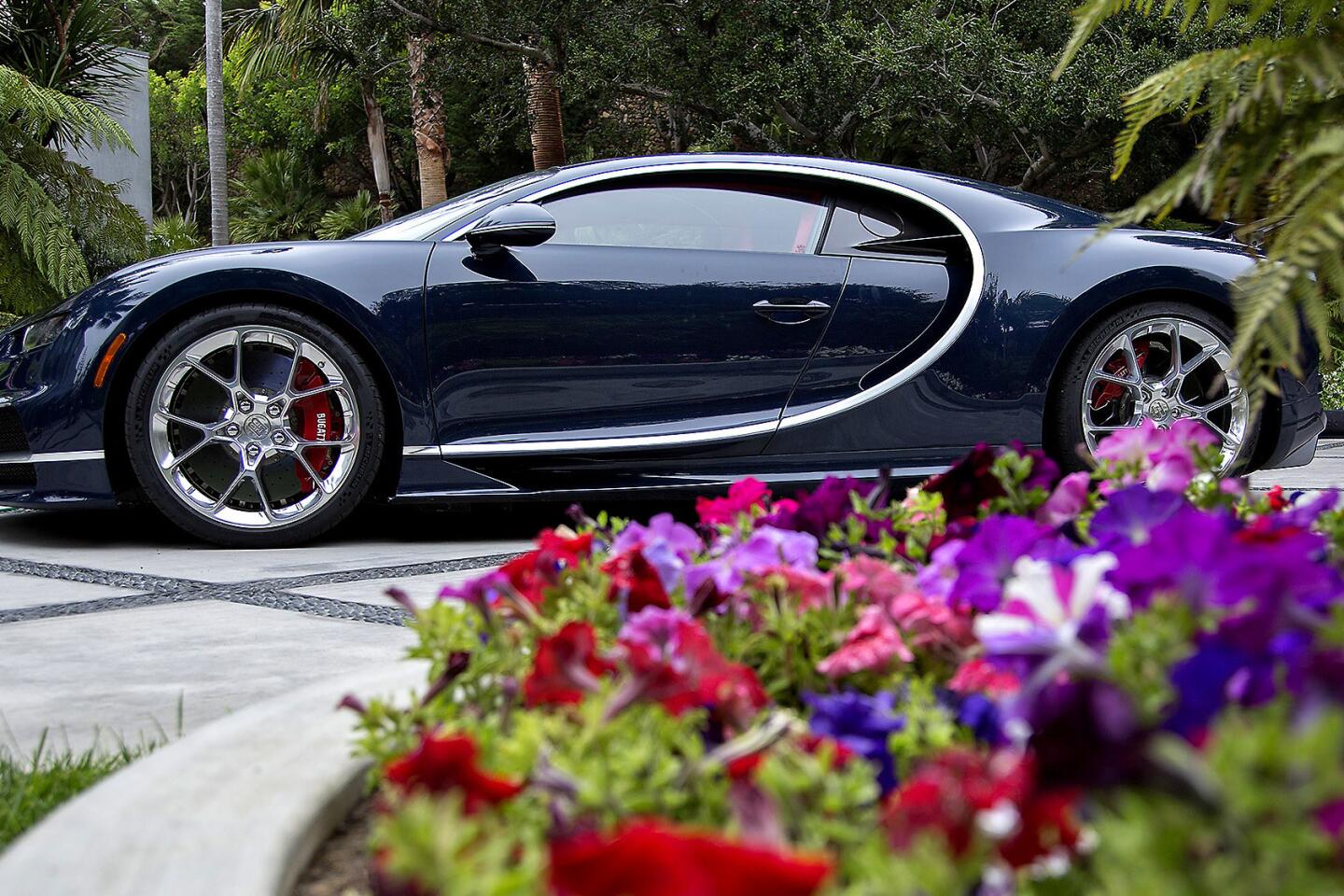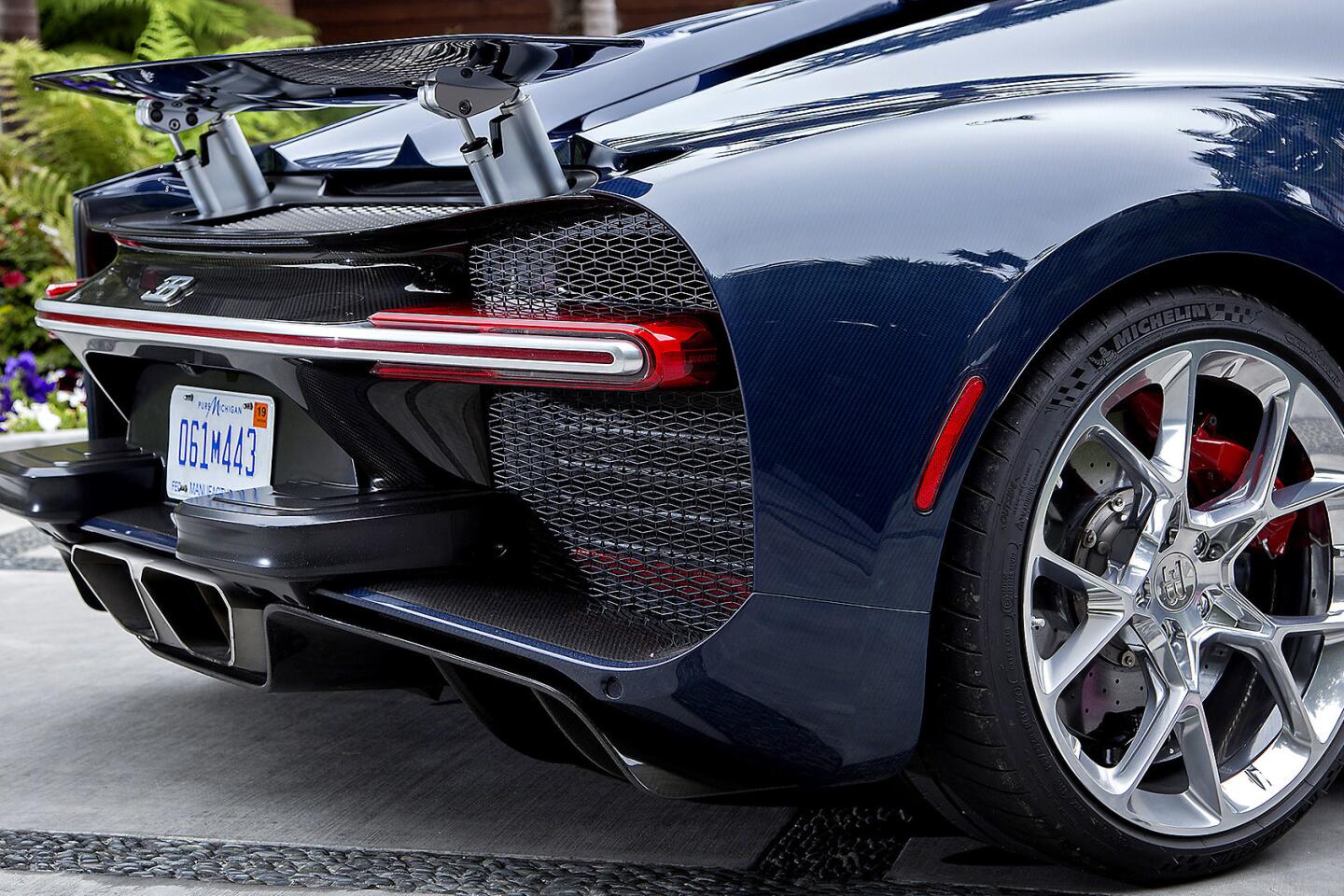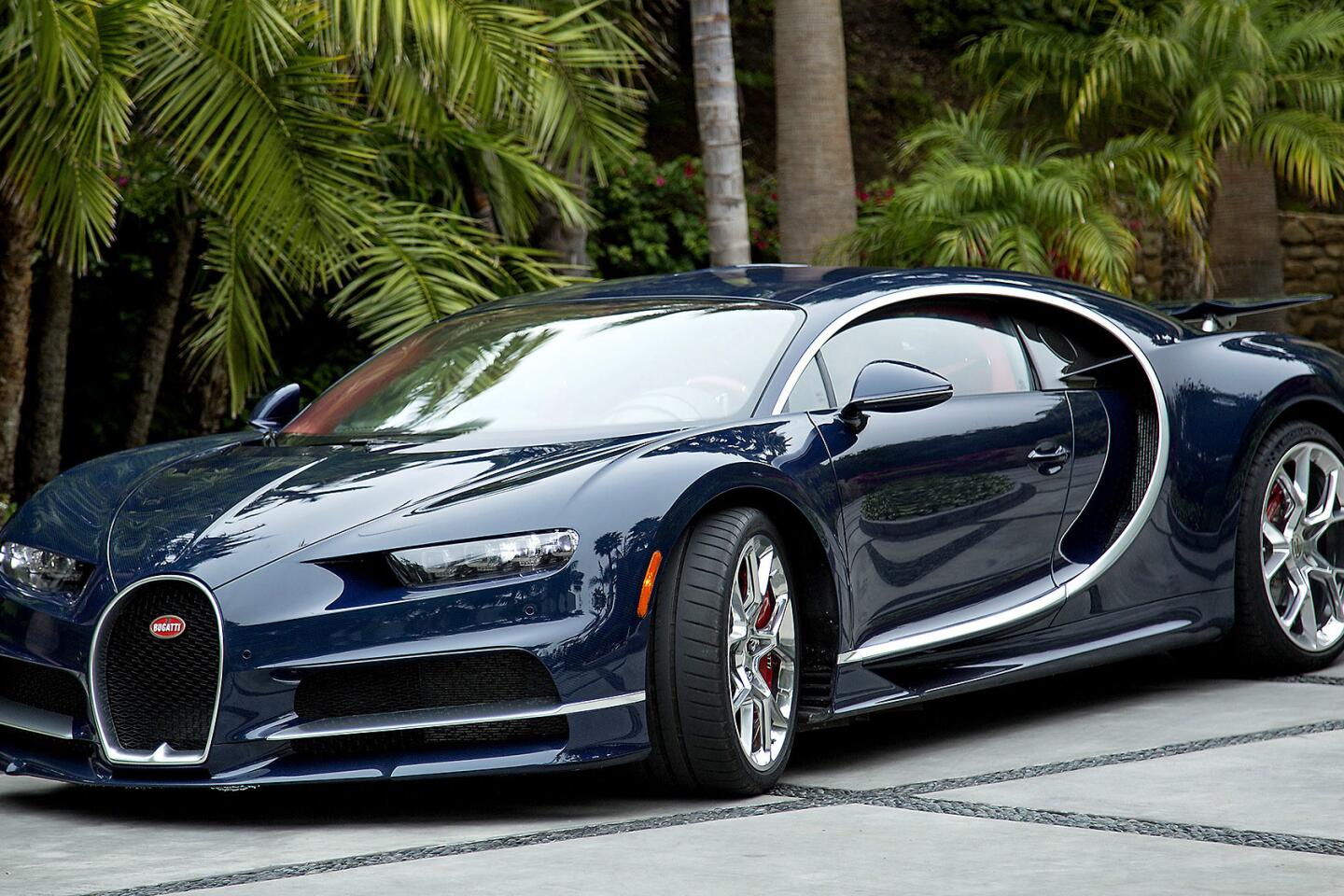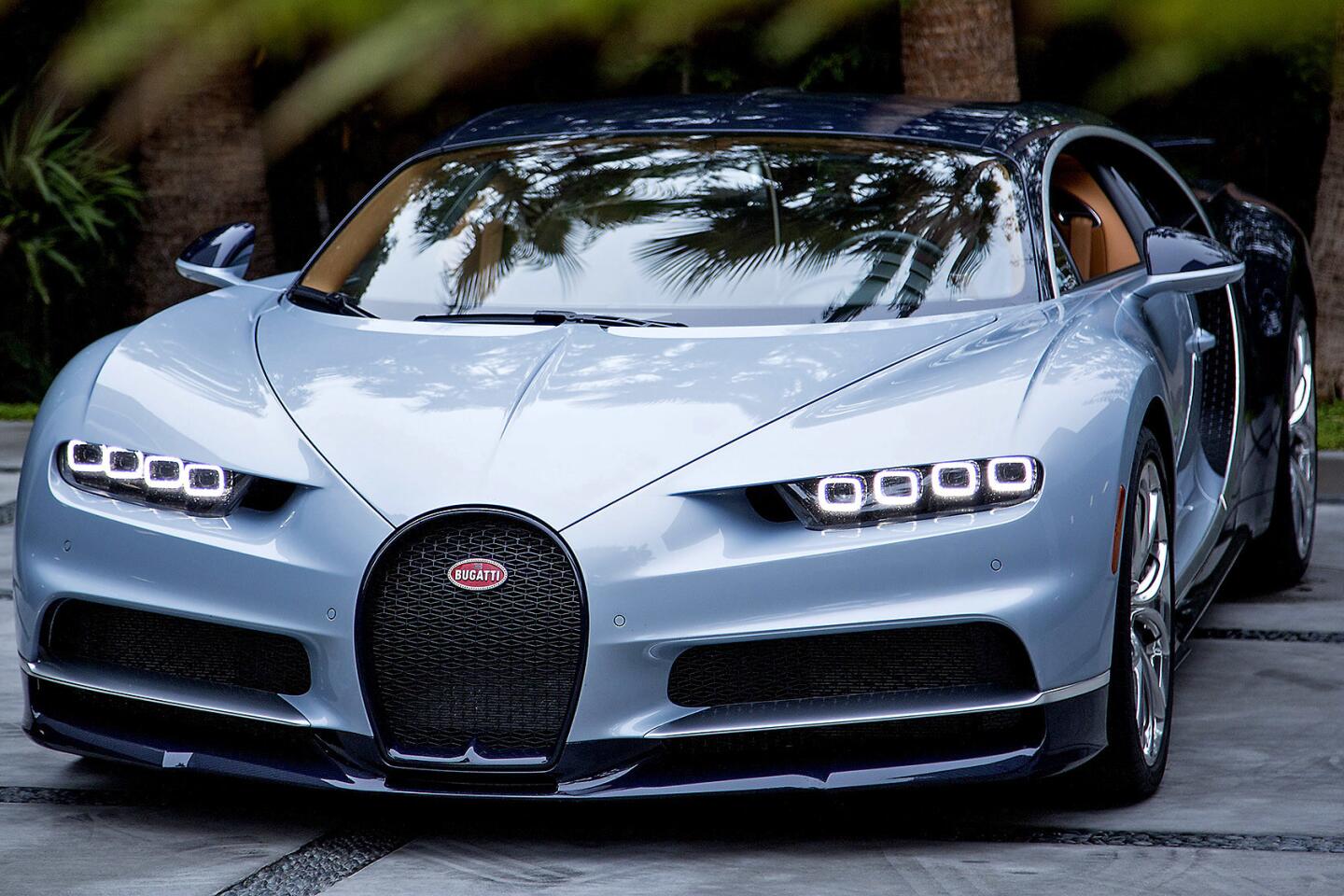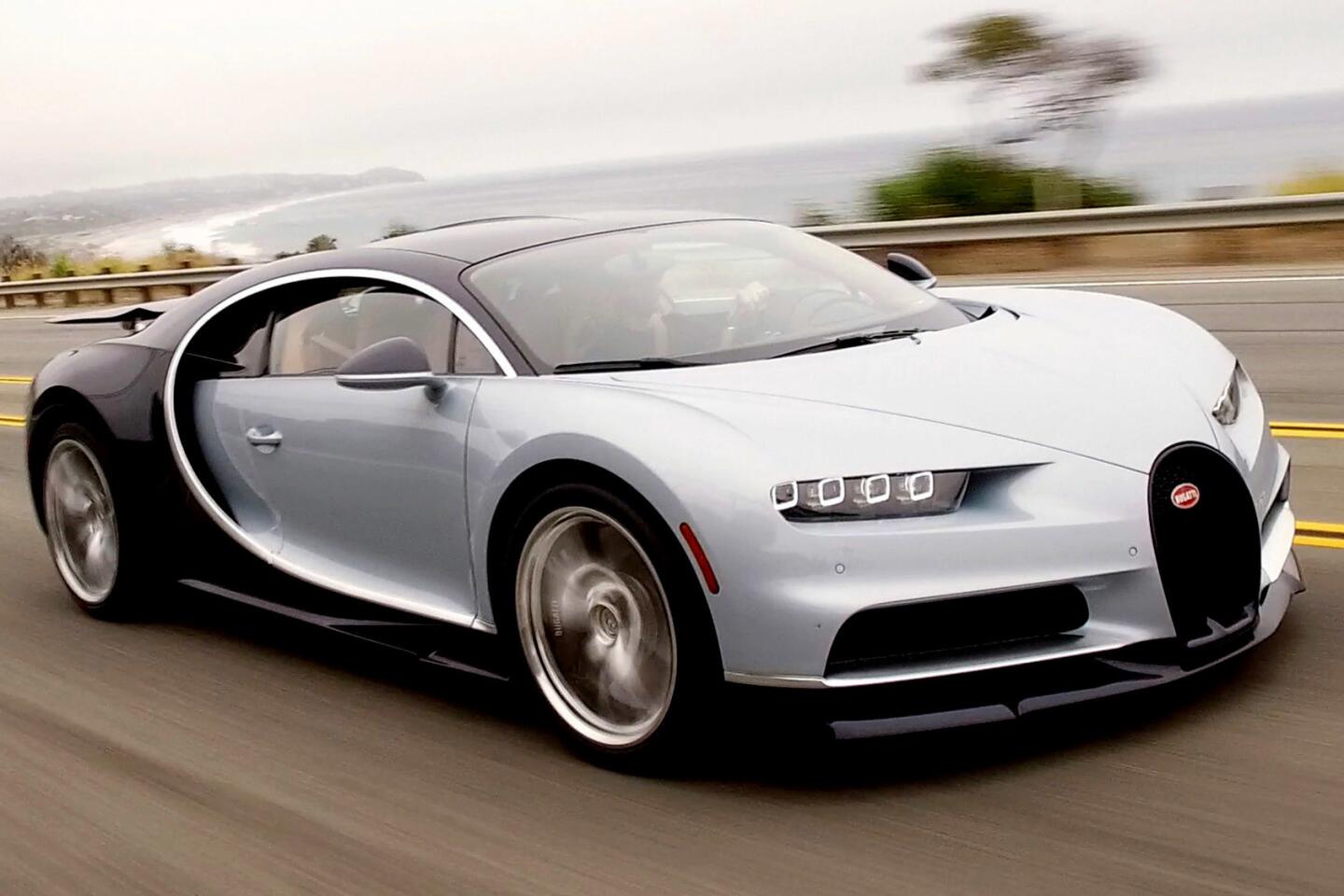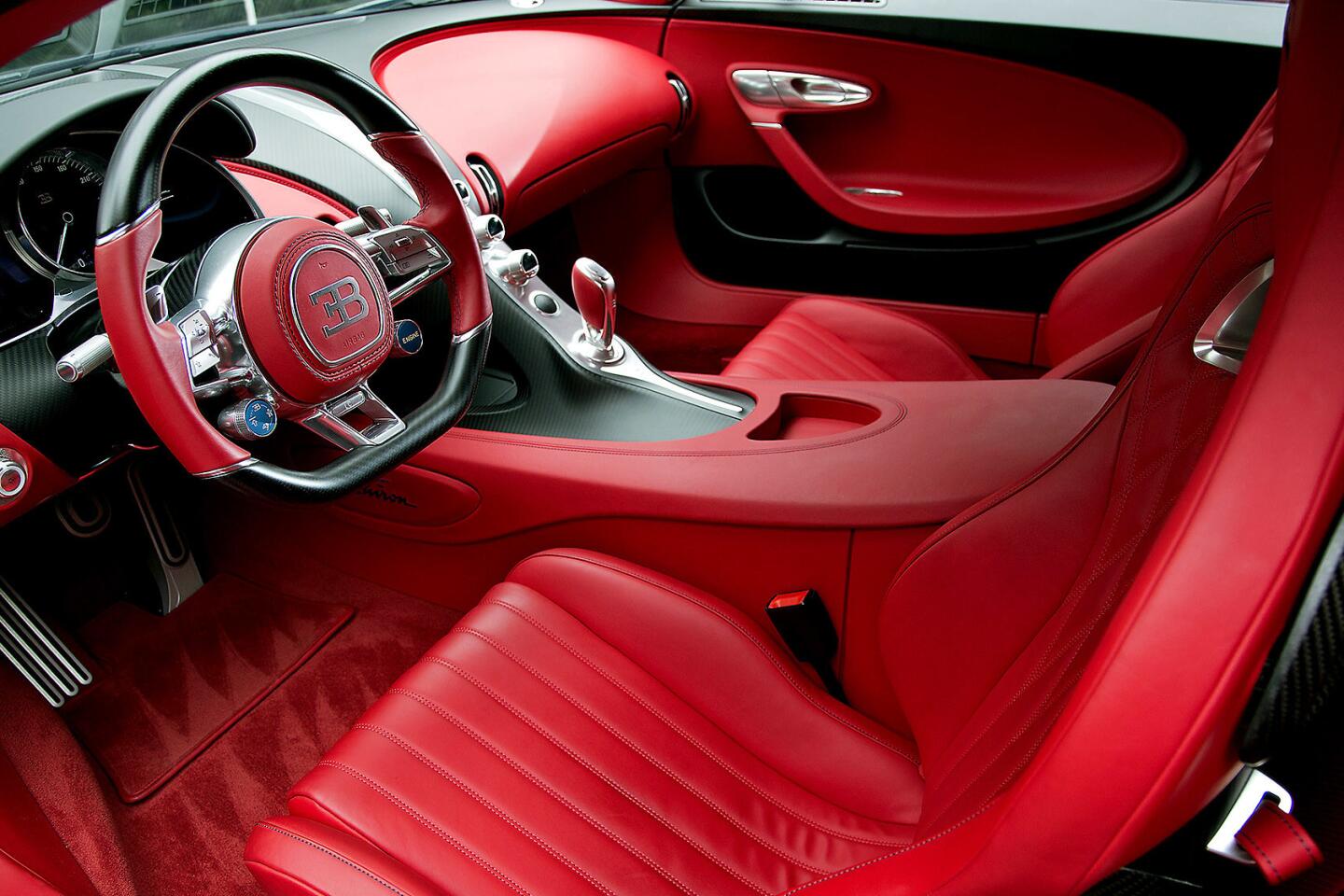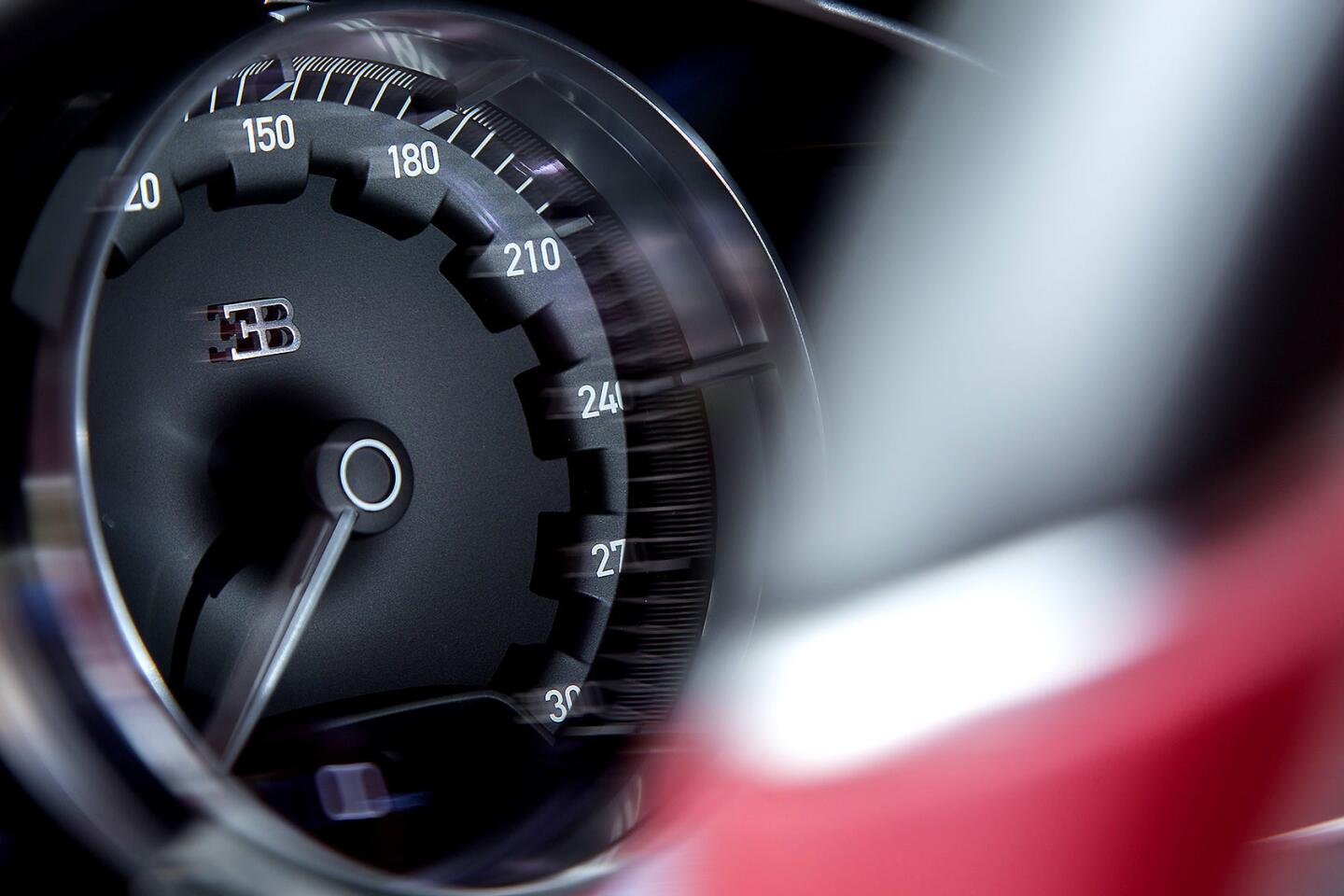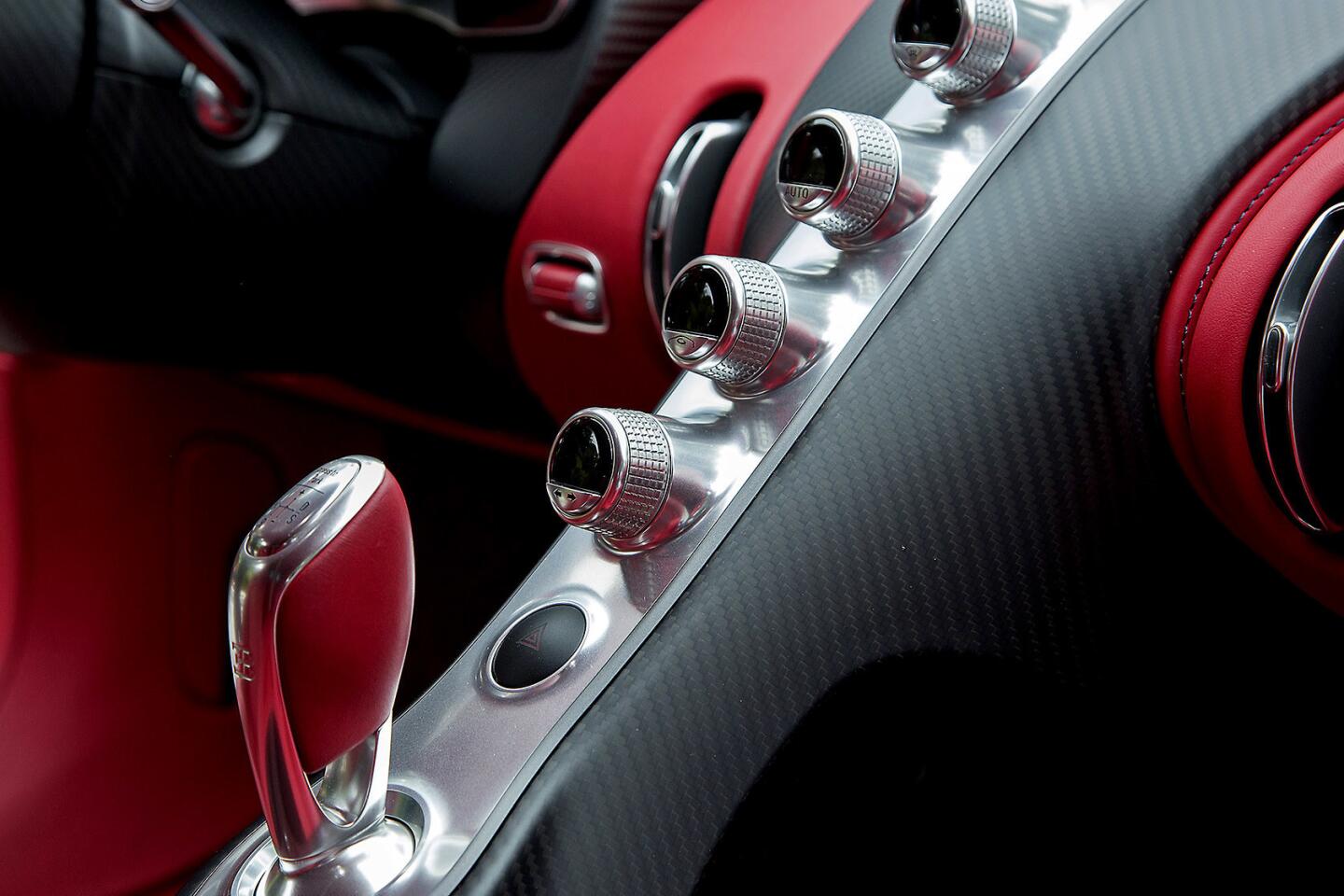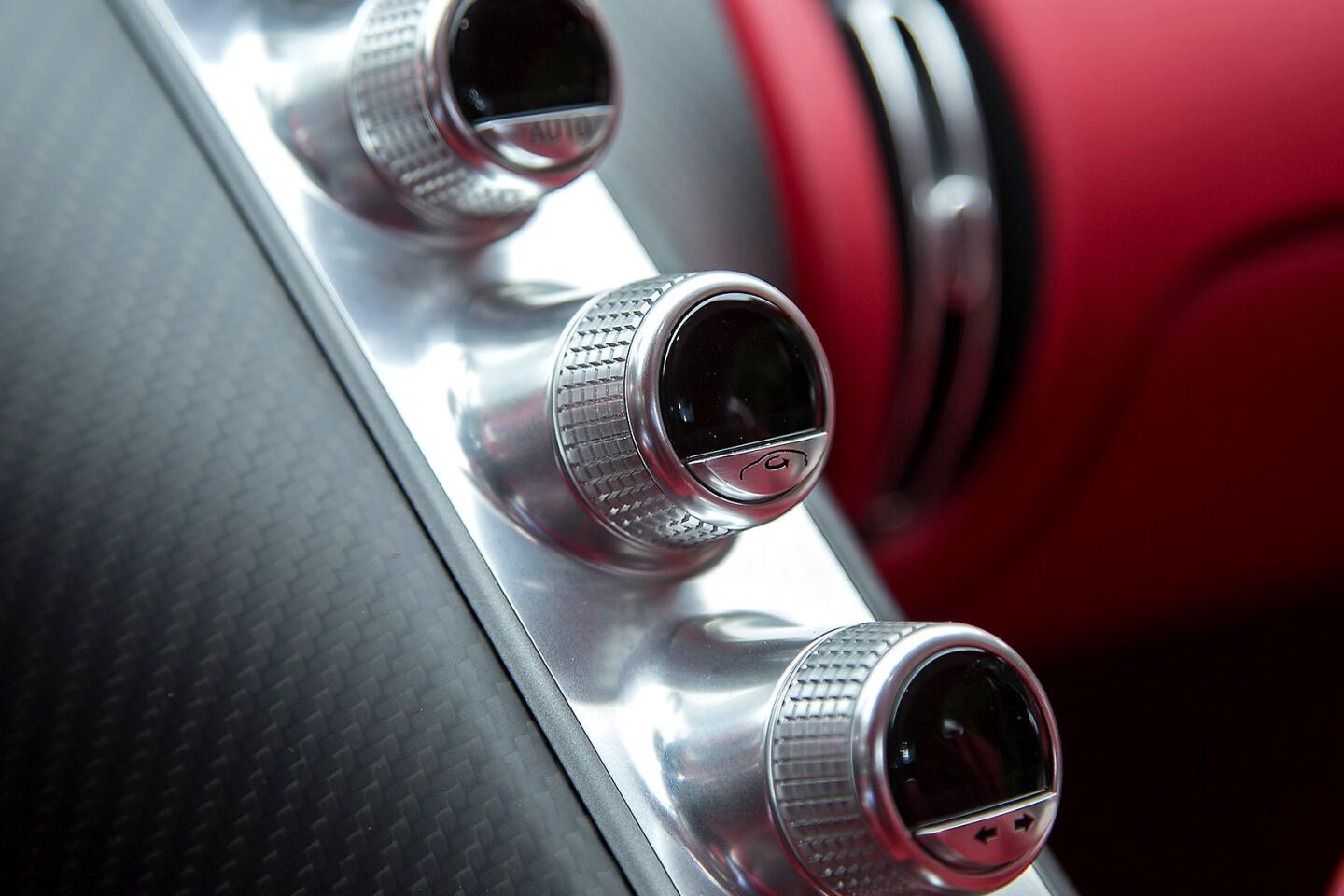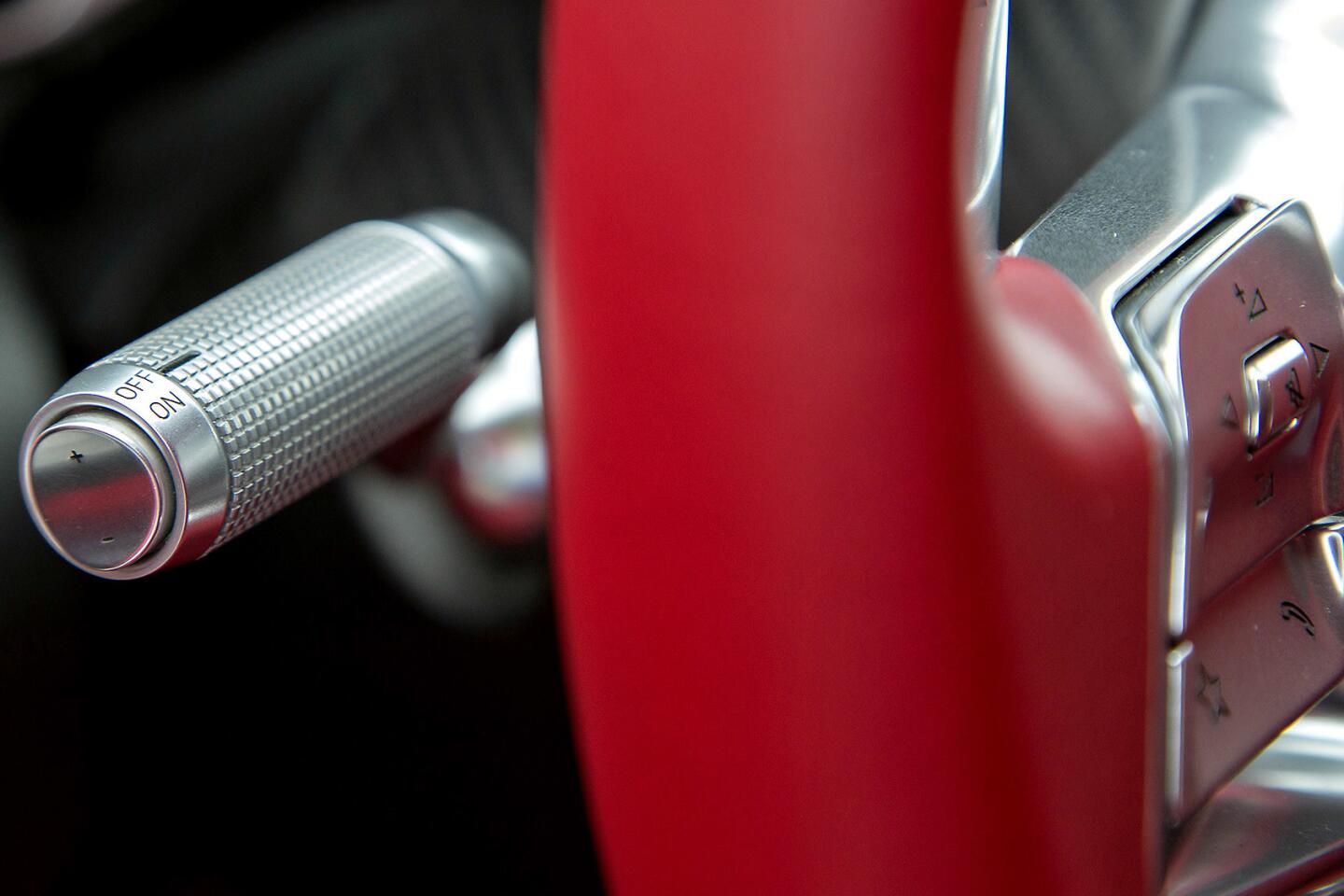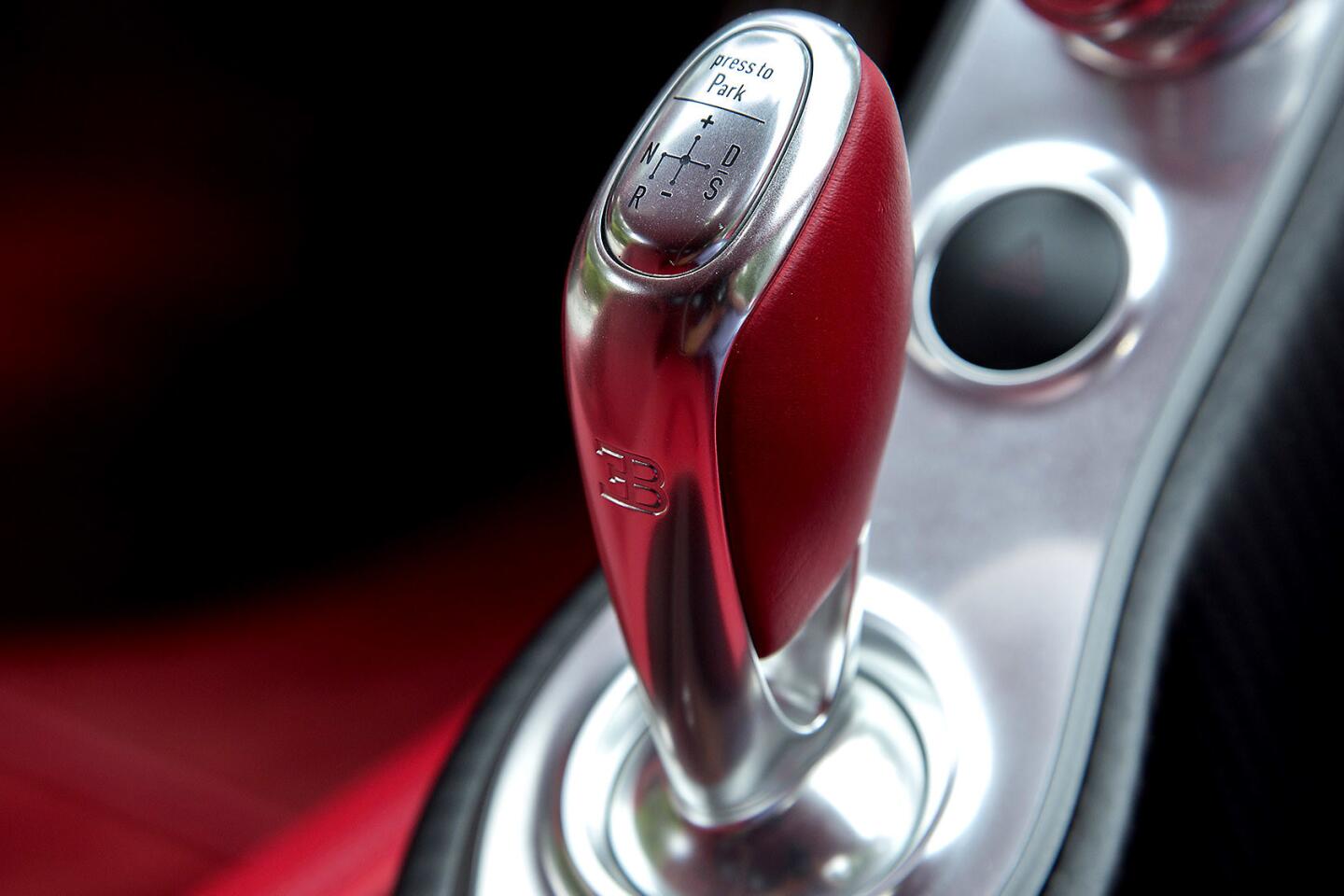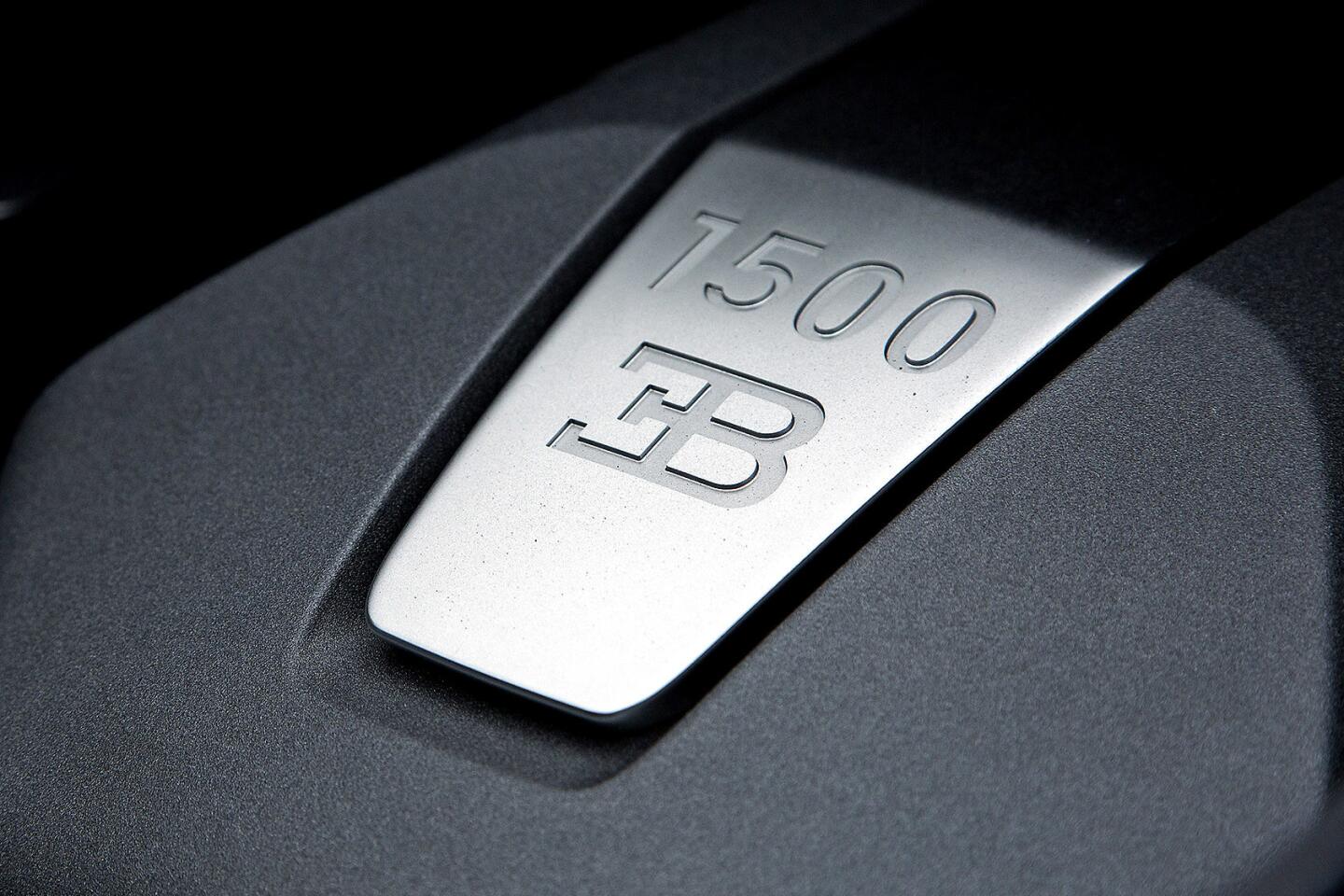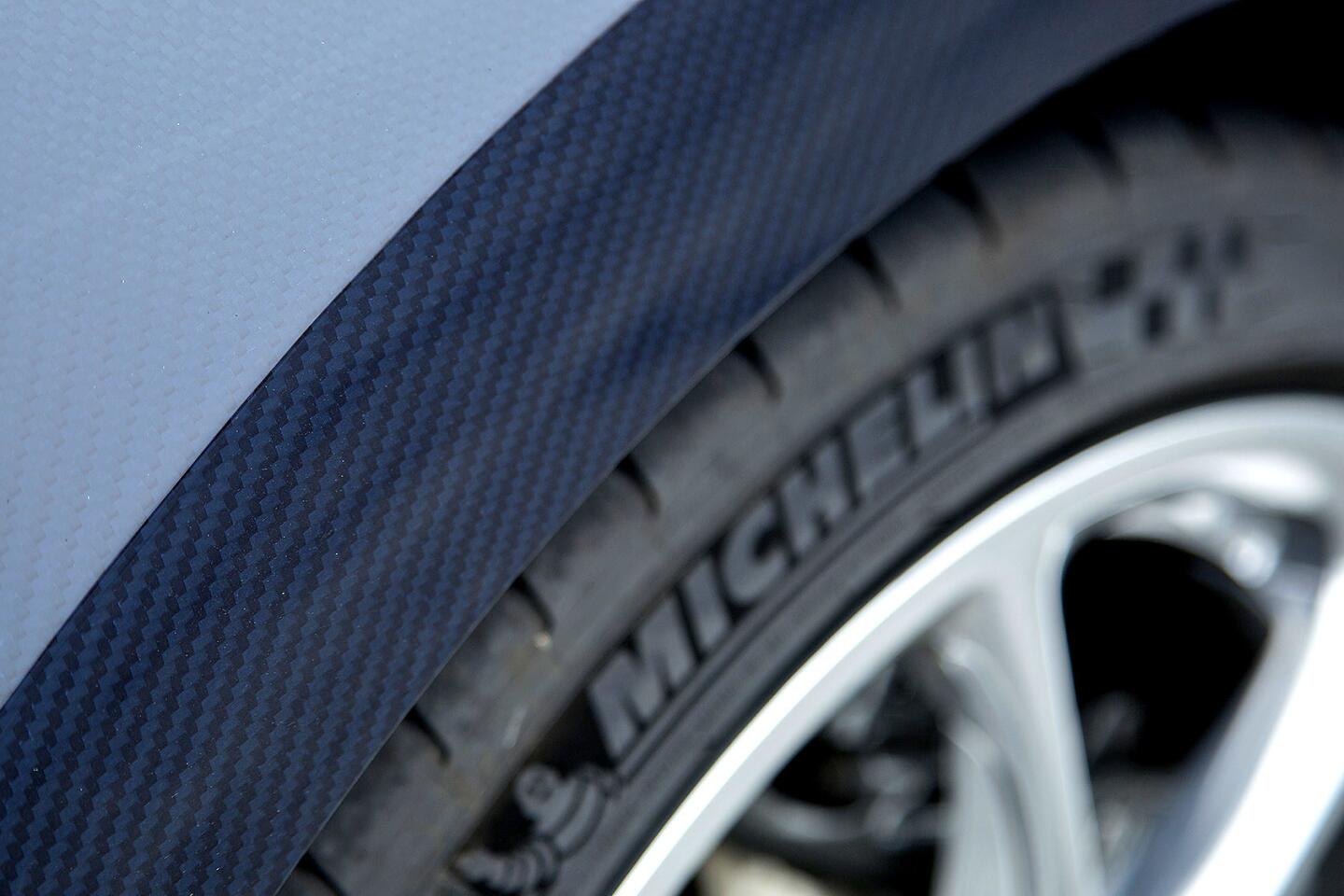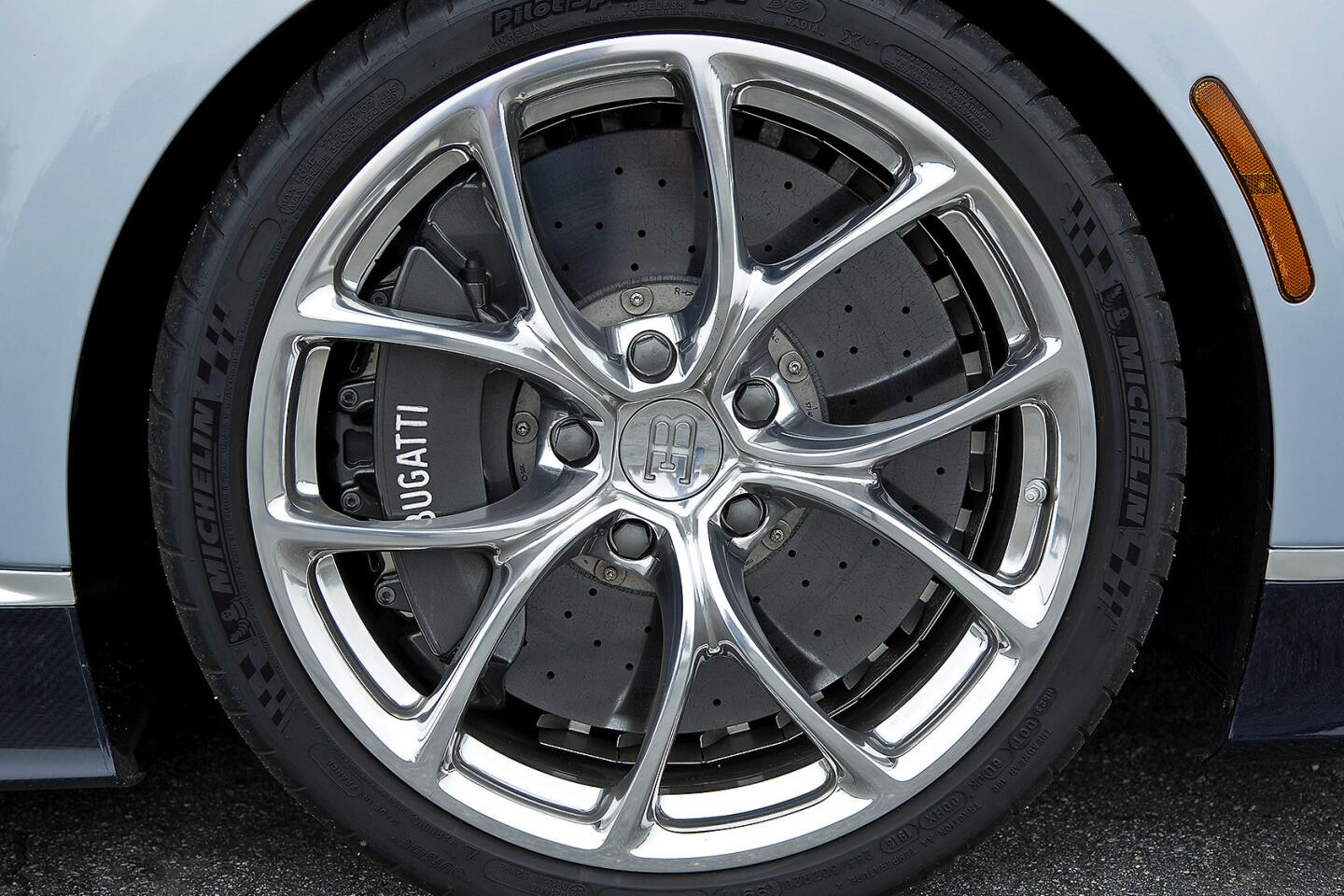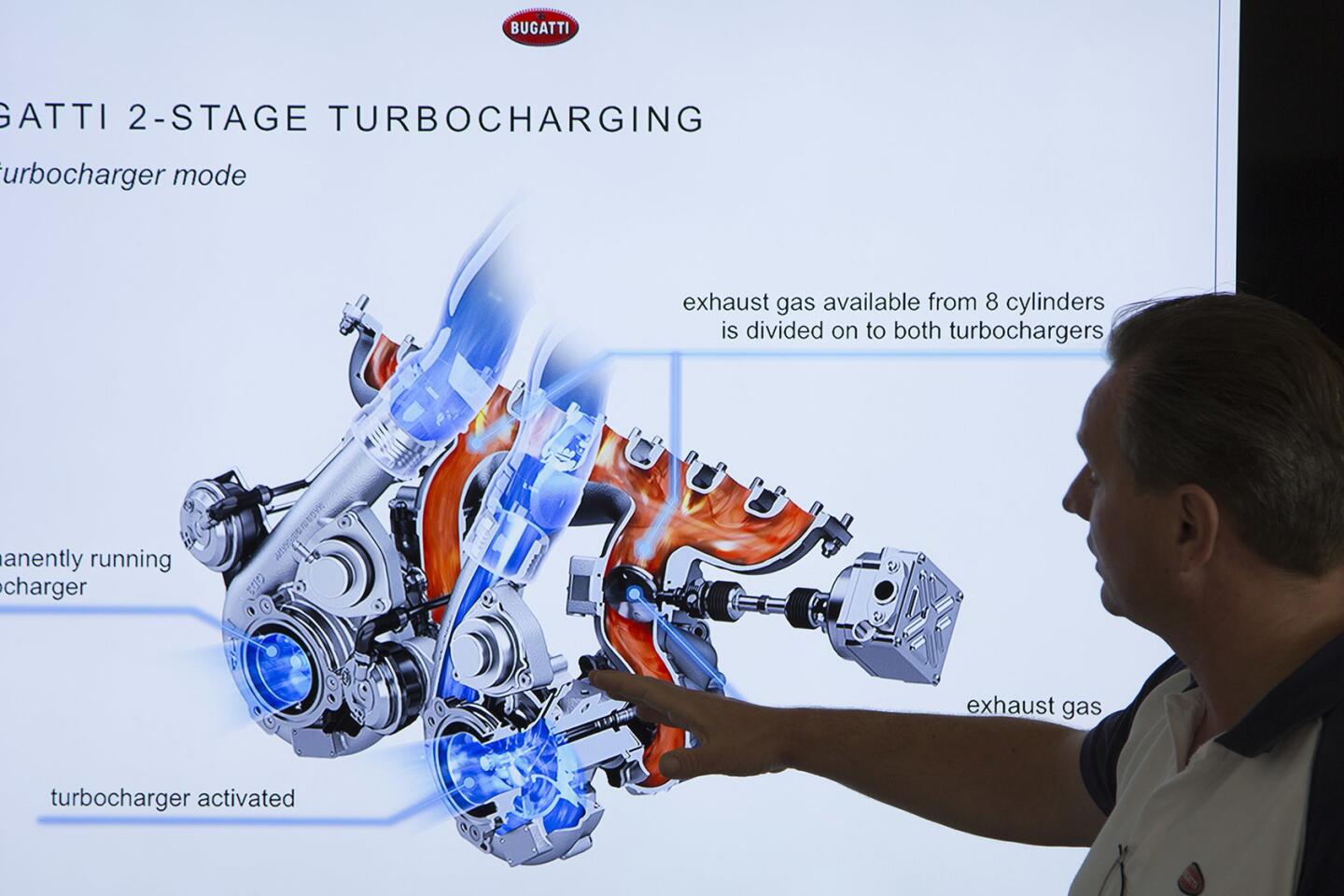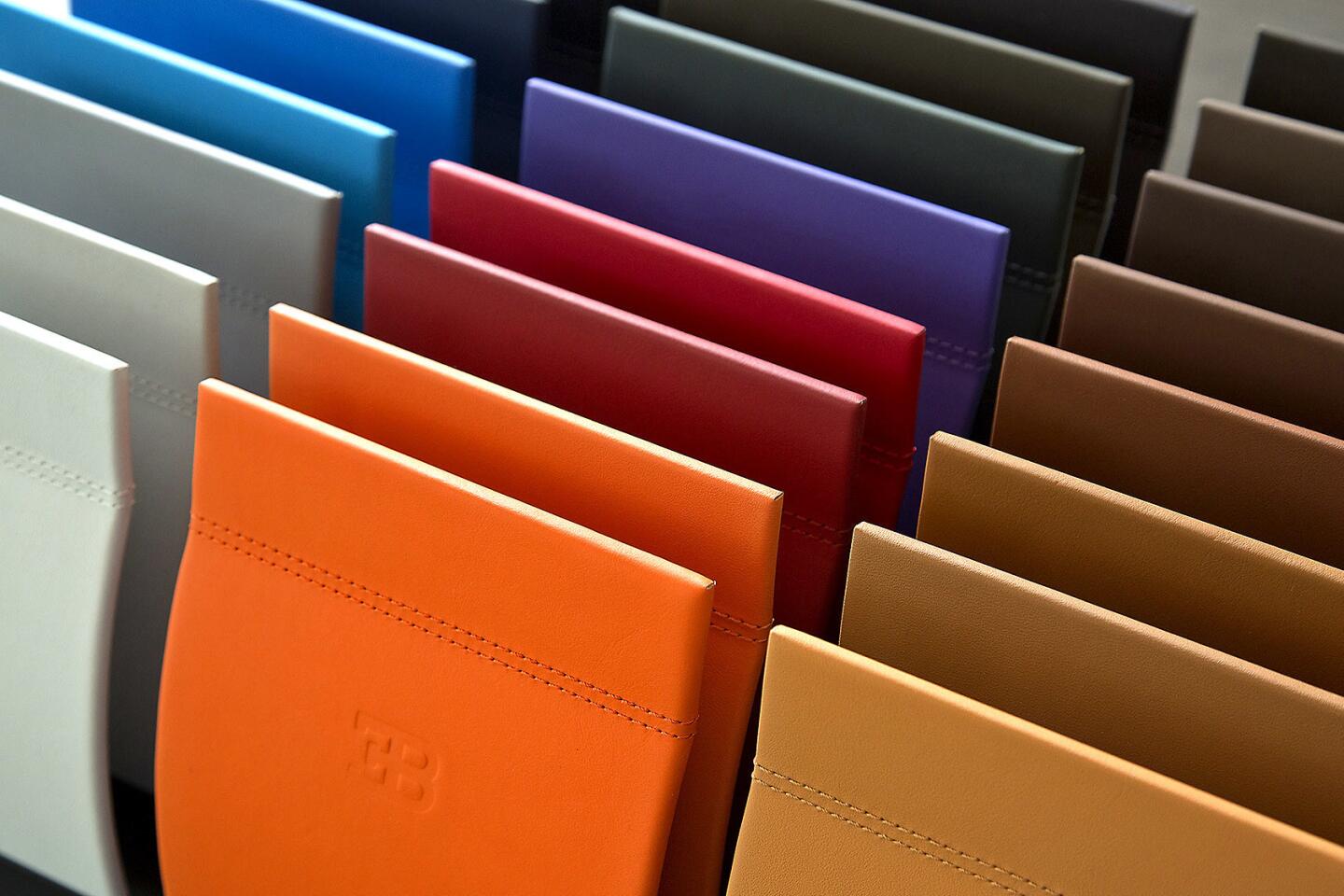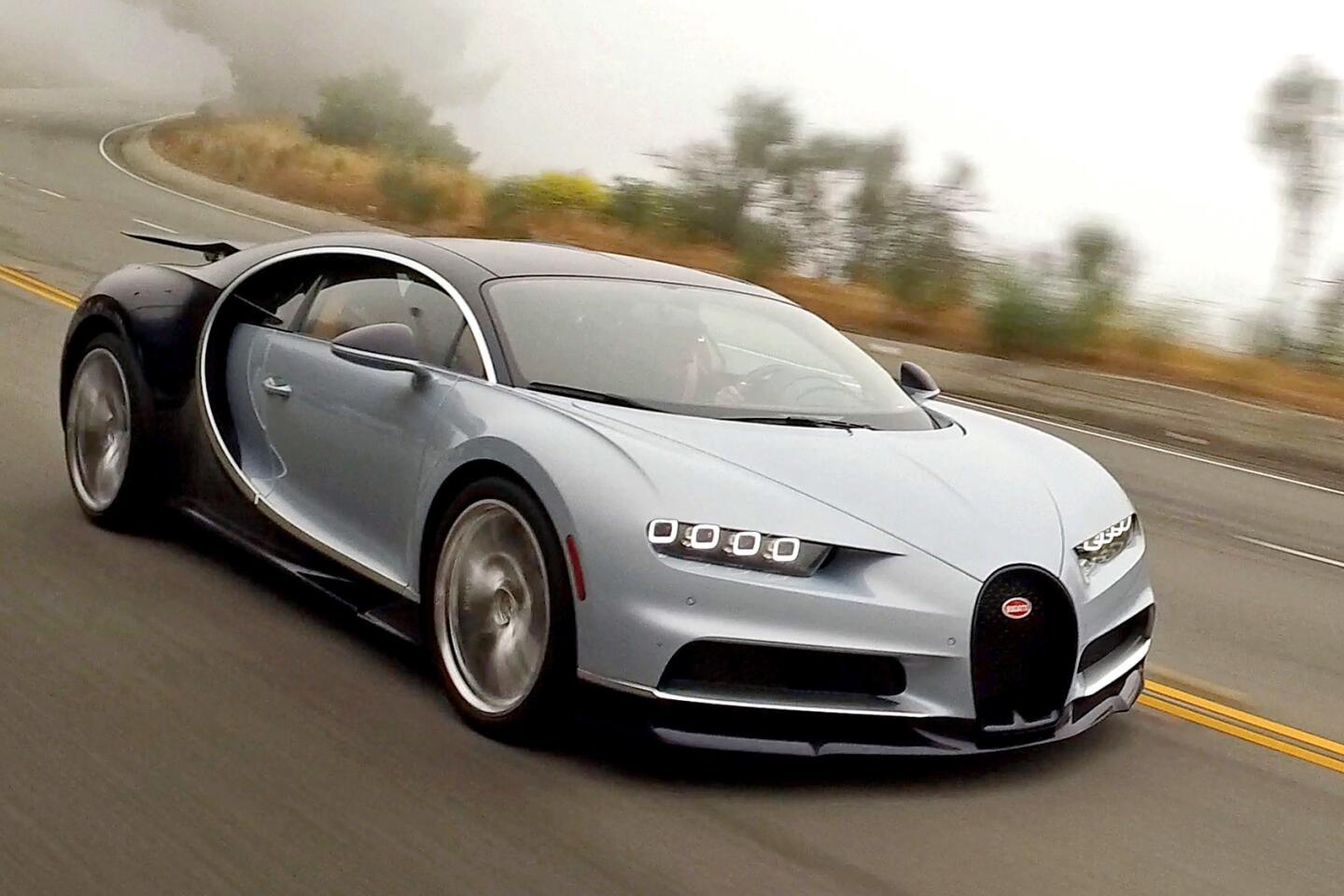Driving the worldâs fastest, most luxurious supercar — the $3-million Bugatti Chiron
Two summers ago, Bugatti CEO Wolfgang Durheimer promised that his company was going to make the fastest, quickest and most luxurious production car ever built.
He declared that the Chiron, named after a celebrated French race car driver who piloted Bugattis to victory during the 1930s, would be a marriage of beauty and beast.
Beauty is in the eye of the beholder. But beast isnât. The Chiron is inarguably the most powerful production car on the planet and its performance is heart-stopping.
The $3-million luxury rocket is powered by a 16-cylinder turbocharged engine that makes 1,500 horsepower, accelerates from zero to 60 miles per hour in under 2.5 seconds and hits a top speed of 261 miles per hour â before an electronic speed limiter prevents it from going any faster.
Itâs a preposterous vehicle, in other words, a singularly silly car so overbuilt and so achingly gorgeous that it is bound to become one of the most sought-after Bugattis of all time.
Bugatti, a division of the huge
The historic marque, founded in 1909 by the Italian-born French designer Ettore Bugatti, boasts a glorious racing history. The signature red and white oval logo, acquired by Volkswagen in 1998, was a dominant Grand Prix marque during the 1920s and 1930s.
In modern times, its previous hypercar under VW ownership, the Veyron, captured the official Guinness record for the worldâs fastest street legal car when it was clocked at 268 miles per hour.
Despite a $1.5-million price tag, which made it then the worldâs most expensive new car, the company sold the Veyrons as fast as it could make them, and had no trouble finding customers for each of the 450 units produced between 2005 and 2013.
Durheimerâs promise to build the worldâs premiere hypercar, then, was a plan to best himself, and design a car that could out-perform the Veyron.
Could that even be done?
I went to Malibu to find out, to meet the Chiron at an exclusive invitational drive event this week.
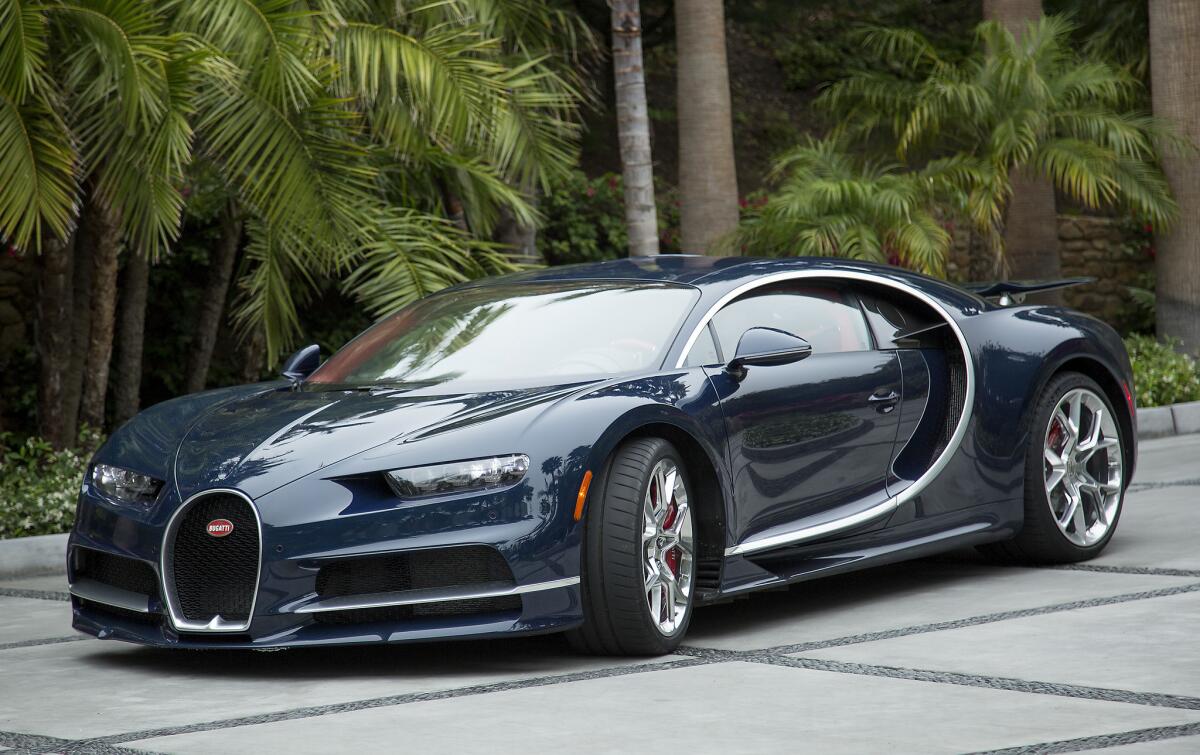
Beauty, beast â or both?
The Malibu event was a chaperoned affair. The company didnât just hand over the keys and say, âSee you next week,â as is typically the case, even with some exotic cars.
Instead, they introduced me to Andy Wallace. The soft-spoken Englishman, a professional driver who raced at Le Mans, Sebring and Daytona for McLaren, Jaguar, Bentley, Audi and others, would be my âco-pilot.â
I slid into the low-slung passenger seat as Wallace walked me through the Chironâs controls. On the left side of the steering wheel were the settings for drive modes â âEBâ for normal driving, âAutobahnâ for high-speed driving, âHandlingâ for racing and drifting, and âTransport,â which raises the vehicle to clear speed bumps or steep driveways.
Near the bottom of the steering wheel was the âlaunch control,â for what Wallace called âmaximum attackâ acceleration.
Below the seat was the âspeed key,â which would allow the driver, under certain conditions, to raise the vehicleâs maximum allowed speed from 236 miles per hour to 261 miles per hour. On a dial in the center console was a screen that would record data such as top speed.
The car chortled to life, its 8-liter W-16 engine, inches behind our heads, gurgling smoothly, as Wallace eased the car up the driveway and onto Pacific Coast Highway.
Heading south, he said, âFor such a powerful hypercar, itâs surprisingly easy to drive. Itâs unbelievably quick, but youâre not afraid itâs going to bite you.â
The Chironâs principal engineer, Martin Grabowski, had explained in a morning presentation that the carâs tractability was the result of dozens of technological innovations.
The power is created by a complex arrangement of four two-stage turbochargers that use captured exhaust gases to increase horsepower. It is delivered to the wheels via a seven-speed dual-clutch transmission that offers the option of automatic or manual paddle-shift modes.
The wheels are kept on the ground by a very stiff carbon fiber monocoque body and an advanced suspension system. Stopping power is supplied by massive carbon fiber brakes.
This was academic, if interesting, until Wallace turned off PCH and headed up Kanan Dume Road.
âWeâll just give these cars a chance to pass us,â he said. âThen you can get a better idea of the acceleration.â
Moments later, the pro driver pressed the gas pedal to the floor. With a rush of turbo inhalation, the Chiron rocketed forward, pressing my spine against the seat and emptying the air from my lungs.
Wallace braked hard as we approached the end of the straightaway. He pointed at a dial on the center console and said, âThereâs the number.â
The dial said 136 mph.
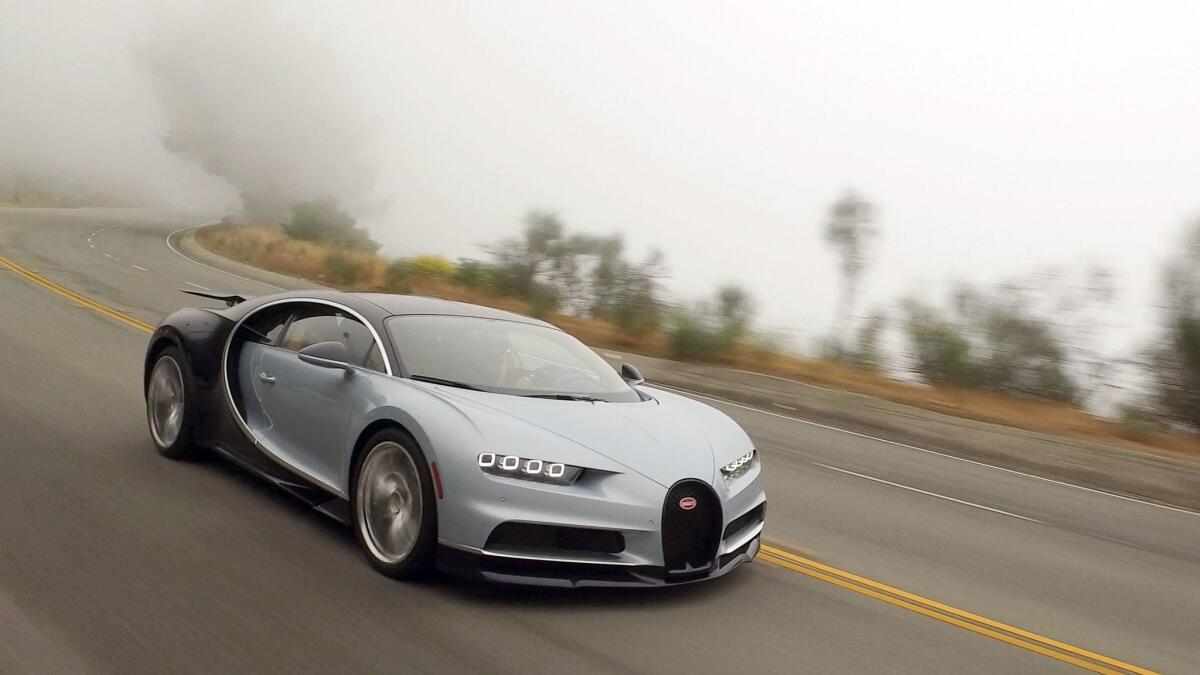
OK, now you
Wallace pulled off the road at the next vista point, got out of the car and said, âReady to give it a try?â
I saw at once what he meant about the Chironâs good manners. Despite the hideous horsepower, the car accelerated and braked smoothly, requiring none of the race-car-driver expertise that I do not possess.
It felt incredibly sticky, clinging to the road as it arced around the tighter turns. Though the asphalt was a little damp from a low fog hanging over us, the tires â developed by Michelin specifically for the Chiron and not found on any other car â didnât slip or squeal as they gripped the road.
As we turned from Kanan onto Mulholland, Wallace said, âNow, put it in first and go.â
I downshifted into first and put the pedal to the floor, turning the roadside brush and scrub into a beige blur for the next several seconds.
After Iâd lifted my foot from the accelerator and began applying the brakes, and found my eyes functioning properly again, Wallace drew my attention to the center console gauge. It bore a number somewhat below the 136 mph figure he had achieved.
âIt doesnât feel that fast, does it?â he said, as my pulse dropped to normal. âQuite smooth, really.â
Wallace, who has been with Bugatti six years and has logged more than 30,000 miles testing the Chiron, said he felt the car was quicker to 124 mph â about 6.5 seconds â than any car heâd ever raced.
Though not authorized to make official predictions on behalf of Bugatti, the former pro driver said his experience with both the Veyron and the Chiron left him believing the new car could far outpace the old.
Top speed, he said, could be above 280 miles per hour. The zero to 60 number could end up below 2.25 seconds.
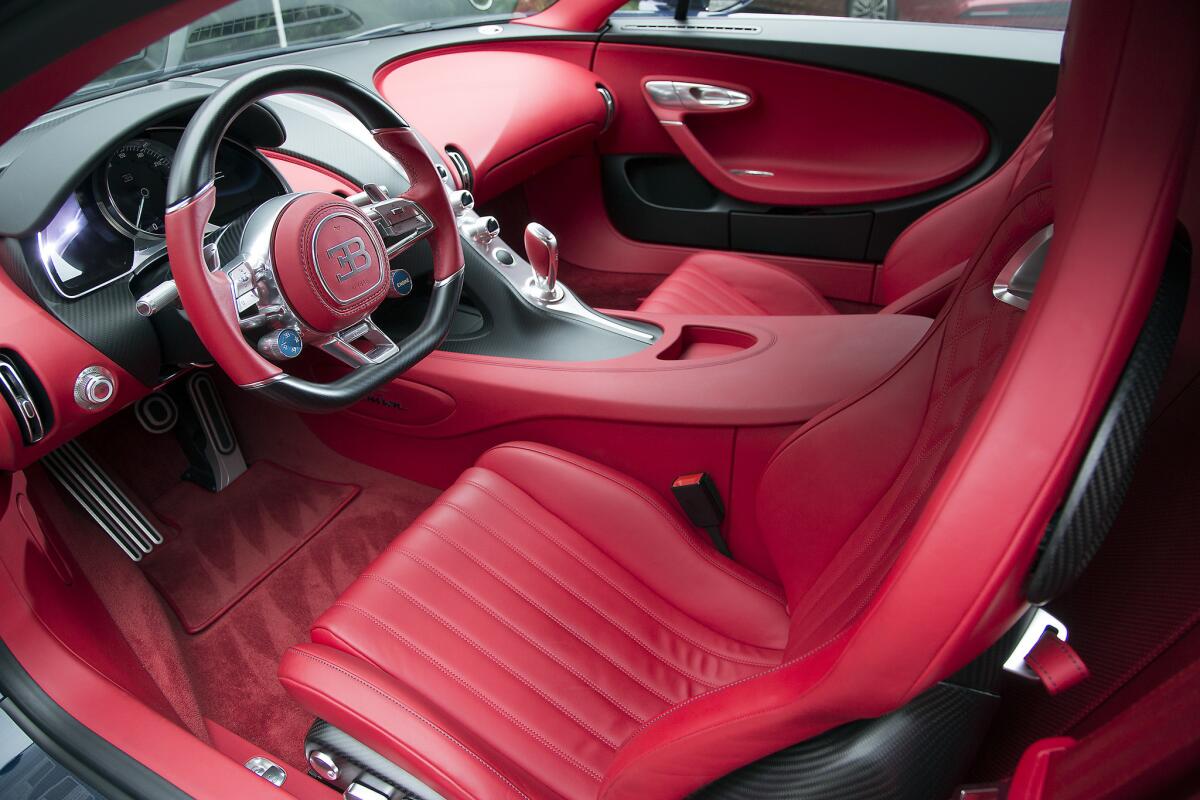
No expense spared
Bugatti has draped its hypercar in unparalleled luxury. The setting for the Chironâs West Coast debut was equally lavish, at a $23-million Malibu estate where an infinity pool dropped away to a view of curling waves, surfers and passing dolphins.
A pair of Chirons were in town for a week, mainly to be driven by customers who had already put down deposits and by other rich folks who Bugatti hopes will buy one. Although the company doesnât break out sales figures by city, officials said they chose the L.A. area as the first U.S. stop because of its importance as a key market.
So far, 270 of the 500 planned cars have been spoken for, and 19 have already been delivered. Thirty percent of the deposits to date came from North American customers.
Under a gray June-gloom sky, the Chirons stood like patient supermodels, posing for photographs in the driveway while their designers gave a slideshow presentation to highlight the carâs unique or unusual features.
Each monocoque body unit, made entirely of layer upon layer of carbon fiber, requires 500 man-hours to build.
Each leather interior, available in 31 colors of calfskin, requires 16 hides to complete. Eight colors of alcantara are also available.
The wide, thin taillight is made from a single piece of hand-brushed aluminum and contains 82 individual LED lights.
The âmacaronâ Bugatti emblem on the radiator grill is made from solid silver â the only piece on the Chiron that weighs more than its Veyron counterpart.
Bugatti Chiron by the numbers:
- Horsepower: 1,500
- Torque: 1,180 pound feet
- Top speed: 261 miles per hour
- Zero to 60: under 2.5 seconds
- Price to U.S. customers: $2.998 million
- Production rate: 2 per week
- Number to be built: 500
- Number to be built this year: 70
- Number sold already: 270
- Delivery date if you order now: late 2020
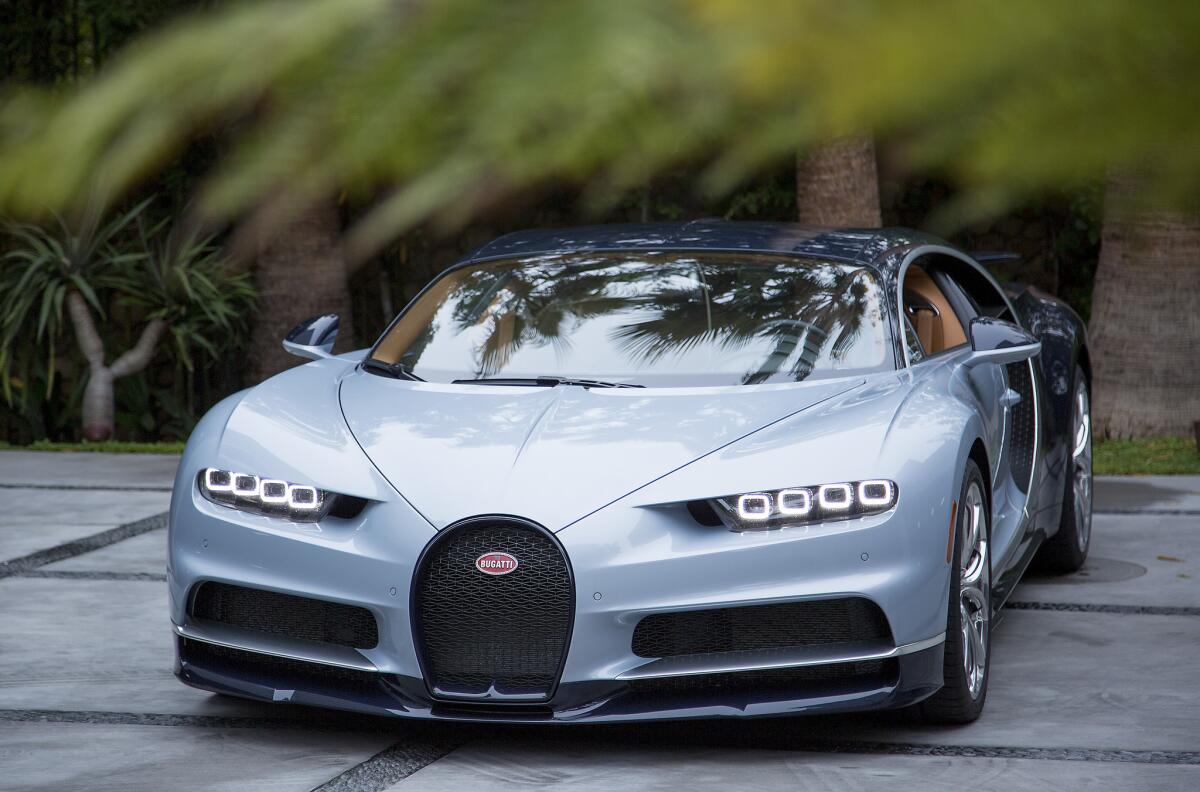
Bugatti head of design Achim Anscheidt stressed that his marching orders always include one central question â the creation of value.
Though the design included iconic Bugatti language, from the horseshoe grill to the slender tail, Anscheidt insisted that âform always follows performance.â
More horsepower required a larger engine, which demanded larger wheels (20-inch in front, 21-inch in the rear), which in turn allowed for larger brakes, which then demanded superior airflow and better brake cooling.
A more powerful engine also creates more heat. The French curve âC-barâ that encircles the driver and passenger doors may hark back to Bugattis of old, but it is also the system by which cooling air is directed onto the massive V-16 power plant.
Anscheidt observed that the overall design, while quite modern, was entirely classical in its dimensions, whose appeal may extend beyond the automotive realm.
âA small waist and wide hips also works on cars,â he said.
Anscheidt, head of Bugattiâs design team since 2004, said the early drawings for the Chiron were made as far back as 2006, a full decade before it was ready for its global debut.
How long before he must be ready to present the next Bugatti, successor to the Veyron and Chiron?
âItâs finished,â Anscheidt said. âItâs in my studio.â
MORE ON AUTOS
Yamaha unwraps super cruiser Venture motorcycle
2017 Chrysler Pacifica: America's first plug-in hybrid minivan
Two things about the Tesla Model 3 that Elon Musk wants you to know
